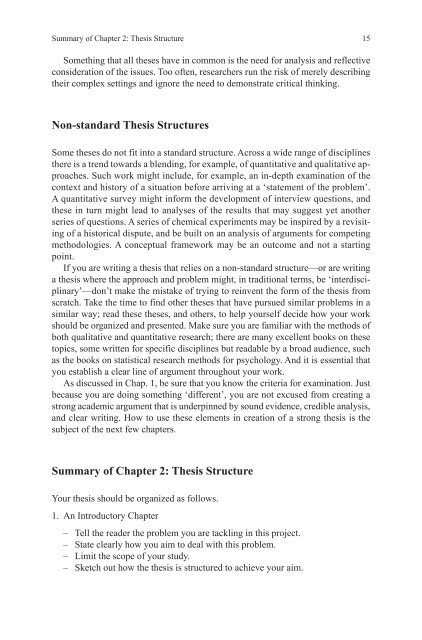How-to-Write-a-Better-Thesis
You also want an ePaper? Increase the reach of your titles
YUMPU automatically turns print PDFs into web optimized ePapers that Google loves.
Summary of Chapter 2: <strong>Thesis</strong> Structure <br />
15<br />
Something that all theses have in common is the need for analysis and reflective<br />
consideration of the issues. Too often, researchers run the risk of merely describing<br />
their complex settings and ignore the need <strong>to</strong> demonstrate critical thinking.<br />
Non-standard <strong>Thesis</strong> Structures<br />
Some theses do not fit in<strong>to</strong> a standard structure. Across a wide range of disciplines<br />
there is a trend <strong>to</strong>wards a blending, for example, of quantitative and qualitative approaches.<br />
Such work might include, for example, an in-depth examination of the<br />
context and his<strong>to</strong>ry of a situation before arriving at a ‘statement of the problem’.<br />
A quantitative survey might inform the development of interview questions, and<br />
these in turn might lead <strong>to</strong> analyses of the results that may suggest yet another<br />
series of questions. A series of chemical experiments may be inspired by a revisiting<br />
of a his<strong>to</strong>rical dispute, and be built on an analysis of arguments for competing<br />
methodologies. A conceptual framework may be an outcome and not a starting<br />
point.<br />
If you are writing a thesis that relies on a non-standard structure—or are writing<br />
a thesis where the approach and problem might, in traditional terms, be ‘interdisciplinary’—don’t<br />
make the mistake of trying <strong>to</strong> reinvent the form of the thesis from<br />
scratch. Take the time <strong>to</strong> find other theses that have pursued similar problems in a<br />
similar way; read these theses, and others, <strong>to</strong> help yourself decide how your work<br />
should be organized and presented. Make sure you are familiar with the methods of<br />
both qualitative and quantitative research; there are many excellent books on these<br />
<strong>to</strong>pics, some written for specific disciplines but readable by a broad audience, such<br />
as the books on statistical research methods for psychology. And it is essential that<br />
you establish a clear line of argument throughout your work.<br />
As discussed in Chap. 1, be sure that you know the criteria for examination. Just<br />
because you are doing something ‘different’, you are not excused from creating a<br />
strong academic argument that is underpinned by sound evidence, credible analysis,<br />
and clear writing. <strong>How</strong> <strong>to</strong> use these elements in creation of a strong thesis is the<br />
subject of the next few chapters.<br />
Summary of Chapter 2: <strong>Thesis</strong> Structure<br />
Your thesis should be organized as follows.<br />
1. An Introduc<strong>to</strong>ry Chapter<br />
– Tell the reader the problem you are tackling in this project.<br />
– State clearly how you aim <strong>to</strong> deal with this problem.<br />
– Limit the scope of your study.<br />
– Sketch out how the thesis is structured <strong>to</strong> achieve your aim.














![[Lonely Planet] Sri Lanka](https://img.yumpu.com/59845622/1/169x260/lonely-planet-sri-lanka.jpg?quality=85)


